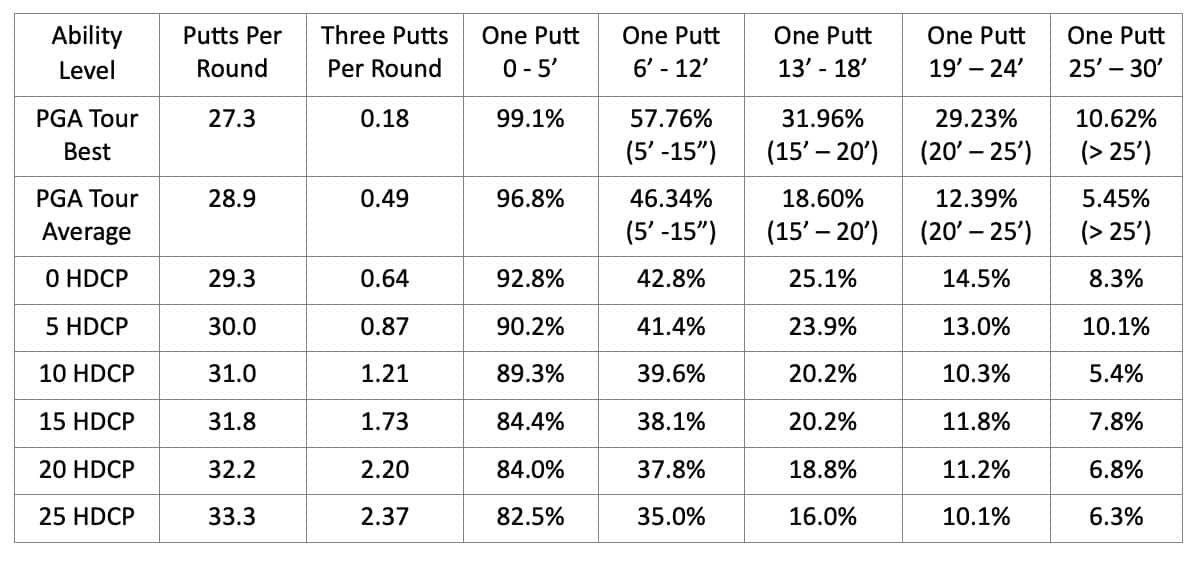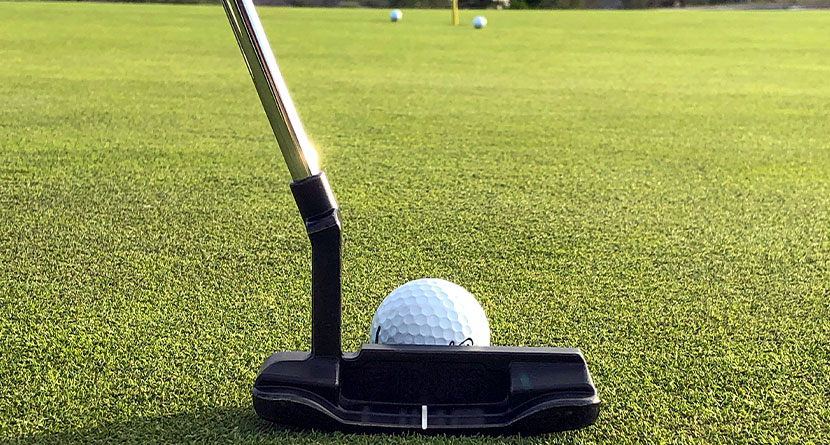By and large, amateur golfers often set unrealistic expectations for themselves in many parts of the game — the number of greens they should hit, how far they hit the ball, and the scores they should shoot are examples of areas where they put needless pressure on themselves.
Where most am’s should focus their efforts are shots on and around the green, not things like Greens in Regulation (GIR) or Driving Distance. After all, shots from 100 yards and in make up about 60% of all the shots you hit in a round. Breaking it down further, putting takes up about 40% of the shots you hit.
Let’s dive into key putting stats to be aware of, help you find where you fall currently, and give you things that will help improve where you sit today.
The areas where amateurs should focus their time and energy when practicing should align with how often they hit particular shots during a round. From a statistical perspective, you now know where the bulk of those shots come from; however, those areas usually differ from where most golfers currently focus their practice time.
Key Putting Stats To Know
The areas to consider in putting, from a statistical perspective, include the following:
- Total Putts Per Round
- Three Putts Per Round
- One Putt Percentage From Key Distances
The following are these areas, broken down by overall ability levels. How do you measure up? Are you falling in line with your current handicap level? Are you better? Are you worse?

The takeaways from these numbers spell out a few things. The best of the best average is anywhere between 4-6 fewer putts per round than a double-digit handicap golfer. You can make the case that better players hit it closer to the hole than a double-digit handicapper, and I agree. However, what is glaringly apparent is that better players make a much higher percentage of putts inside 10’ -12’ than a double-digit handicapper. They also do not three-putt nearly as much.
I have long believed that the one area of the game where average golfers could improve immensely and perhaps even get into PGA Tour statistical numbers is in putting.
Hitting the ball like Rory McIlroy, Jon Rahm, or Scottie Scheffler would take far too much time, effort, and more than most average golfers could ever devote to. With putting, however, you can practice it virtually anywhere, at home, on the road in a hotel, in the office, and really anywhere.
How to Practice Improving Your Putting and Improve Your Stats
The areas average golfers need to improve in their putting include set-up, stroke, line, and tempo. In many ways, one thing will take care of the next. If your set-up fundamentals are solid, then your chances of having a good path and line are improved. Here are some things to work on in these areas…
Putting Set-Up
- Your toes, knees, hips, and shoulders must all be parallel left of your target line (for righties).
- Bend slightly forward from your hips, roughly 25 degrees from standing vertically.
- Your arms should hang straight down naturally, under your shoulders, with your elbows slightly bent towards the bottom of your rib cage.
- In doing the above, you will create a triangle made up of your squared shoulders and your arms hanging straight down from them. As you grip the putter, you will complete that triangle.
- For good posture, make sure your eyes are over the ball. This will aid in allowing you to have a nice back and through stroke.
Putting Stroke & Line
The components of a good stroke start with having good set-up conditions, as mentioned above. Amateur golfers (and even the pros) often need to work on a poor path with their putter head or with poor face control.
For a right-handed golfer, pulled or left misses and pushed or right missed putts each come from three areas.

Using alignment sticks, set up on both sides of the ball, or setting up gates using tees, will help to train a stroke that is squarer going back and coming through. It is important to note that as putts get longer, there will be a small degree of arc in the later part of the backstroke and through stroke.
In terms of getting a good start line, you will need to become more in tune with finding the right line for your putt. To become a better green reader, you can work on the following:
- From back in the fairway, look at the topography of the green. This will help you start to get a feel for how it moves.
- Watch from the fairway how golf balls react when they hit the putting green.
- Watch how your playing partner’s ball moves when they putt.
- Look at your putt from all sides, not just the down-the-line perspective.
- If you are putting on a grainier surface, such as with Bermuda Greens, look to see how the grain moves. If your putt has a shiny look to the grass, its down grain, a little duller look will be into the grain. You can look at the cup too. One side of the hole will look slightly more ragged than the other. That chewed-up or rough side will be the direction the grain is going.
Tempo
One of the most important aspects of good putting is tempo. Not to be confused with speed, tempo is the overall rate of your entire stroke. The time of your backstroke and the time of your through stroke. All great putters putt at a rate right around a 2:1 ratio. What is meant by this is that the clocked time of their through stroke is twice as fast as the recorded time of their backstroke.
All golfers are different; some have a faster speed to their putting stroke, and others slightly slower, but regardless, good putters stick to that 2:1 ratio.
The length of the putt should not change the tempo either. Longer putts require a longer length of stroke. Your tempo should always remain at a 2:1 ratio, even on those longer putts. A great way to train your putting tempo is with the Blast Motion Golf Sensor, or with a metronome app called Golf BPM.




